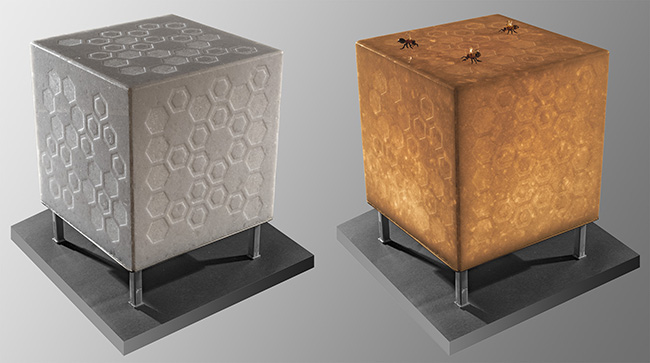
Nell’arte, così come nella quotidianità contemporanee molto spesso si tende a voler raggiungere la conoscenza, la verità, come se questa potesse essere conseguibile in senso assoluto e totale, come se di fatto non esistessero differenti versioni subordinate all’approccio e all’angolatura di osservazione di ciascun individuo; gli artisti più sensibili, più attenti alla relatività della realtà hanno invece un tipo di atteggiamento differente, quello cioè di accettare il possibilismo, l’innegabile concetto che tutto possa avere un aspetto soggettivo e dunque non possa essere indotta o spiegata o data per certa una sola verità, e di diventare così il mezzo per indurre gli altri a riflettere, meditare e a scoprire le molteplici sfaccettature di tutto ciò che appartiene all’esistenza quotidiana. La protagonista di oggi, con la sua molteplicità stilistica, mostra in ogni sua opera esattamente questo aspetto filosofico che si concretizza nelle sue creazioni luminose da cui ricevere emozioni diverse a seconda che si osservino al buio o alla luce del sole.
Nell’ambito di quei decenni rivoluzionari e avanguardisti che contraddistinsero l’inizio del Ventesimo secolo, si ripresero e ampliarono molti princìpi teorizzati da movimenti precedenti, trasformandoli e adattandoli a un nuovo modo di osservare e generare l’arte, ma si diede anche corpo a un inedito approccio volto a rompere gli schemi e i legami con le regole accademiche e con una figurazione che non sembrava più essere sufficiente all’inclinazione dei creativi di quegli anni. In particolar modo vi furono correnti che dettarono nuove leggi, nuove possibilità anche per quanto riguardava la cooperazione tra forme espressive differenti, permettendo all’artigianato, all’architettura, al design di interni e alla decorazione di interagire direttamente con un’opera o diventare addirittura un’inedita forma artistica fino a poco prima considerata come minore se non meramente una disciplina tecnica. Già con l’Arts and Crafts inglese si cominciò a delineare il desiderio di una sinergia, di un’interazione profonda che non permettesse più all’artigianato di essere considerato di serie b piuttosto di integrare con le sue tecniche esecutive l’arte; la sua evoluzione nell’Art Nouveau francese e belga e nel Modernismo catalano, si manifestò nelle vetrate decorate, nella produzione di mobili e nell’architettura di cui rimangono tutt’oggi testimonianze sbalorditive di quella che di fatto fu una vera e propria rivoluzione. Allo stesso modo qualche anno dopo a Weimar in Germania, riprendendo il concetto dell’unione e dell’interazione delle forme espressive, nacque e si consolidò una scuola di arti applicate, la Bahuaus, che divenne un movimento in cui gli allievi e gli insegnanti cooperavano per studiare e interpretare il nuovo pensiero creativo tendente all’Informale, all’Astrattismo, al Razionalismo e al Funzionalismo, dove la progettazione e la realizzazione di un’opera si estendevano non solo alla forma finale bensì anche ai materiali e alla loro interazione con l’esterno ma anche con l’affinità estetica, l’equilibrio plastico e l’impatto conclusivo. Di fatto fu proprio nella scuola di Weimar che cominciò a inserirsi e a delinearsi il rapporto, oggi implementato e ampliato, tra cultura e tecnologia aggiungendo pertanto all’intuizione dell’Arts and Crafts i primi passi verso la digitalizzazione oggi essenziale in molti campi. È proprio in questo specifico aspetto che si inserisce il temperamento artistico dell’artista ligure Ivana Vio, la sua necessità intuitiva di andare a esplorare, a sinergizzare e ad approfondire le reazioni e i comportamenti di materiali che va ad associare nelle sue opere attraverso tecniche quasi scientifiche, apprese nella professione di architetto, in virtù delle quali riesce a dare originalità, stile e armonia a tutto ciò che crea.
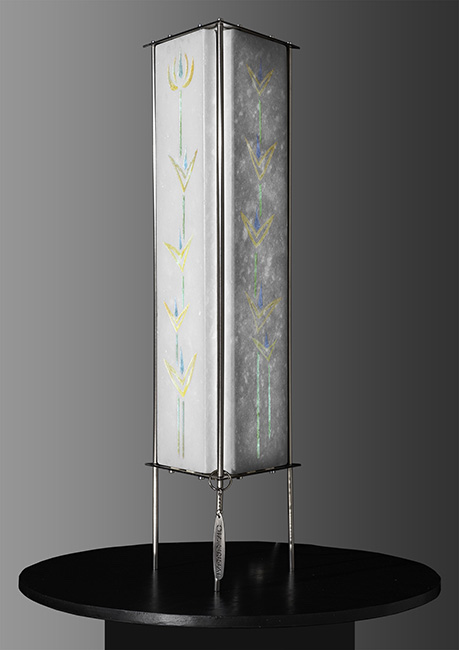
Nel suo percorso artistico, da sempre affiancante quello lavorativo, si misura con molteplici tecniche, dalla scultura alla Computer Art, dalla fotografia alla Body Art, dall’incisione allo sbalzo su metallo, quasi ripetendo l’esperienza della Bauhaus, da lei percorsa però in maniera indipendente scegliendo di frequentare le botteghe artistiche di due grandi maestri genovesi, lo scultore Quinto Testore e il pittore Rocco Borella, e soprattutto arricchendola di quello che è il suo elemento distintivo, la luce.

Sì perché le opere di Ivana Vio sono sculture che di fatto si possono accendere, osservandone dettagli che quando sono spente restano invisibili o appena accennati, oppure possono essere ammirate alla luce del giorno, dove i rilievi e le aperture dei materiali utilizzati lasciano emergere ombreggiature e contrasti che con la luce si dissolvono; la sua ricerca artistica si focalizza sull’esplorazione di tecniche non convenzionali per modellare il marmo e il metallo, sul tentare vie audaci per rendere uniche le sue creazioni, anche attraverso l’elettrogalvanica con cui lascia interagire e dialogare il metallo meno nobile con quello più prezioso ma anche per evidenziare venature o solchi del marmo. L’alternanza tra luce e ombre accresce dunque anche l’effetto generato dal metallo prezioso, l’oro, che appare in molte sue opere quasi come se il suo intervento completasse il necessario passaggio tra uno stato e l’altro, quello acceso e quello spento, attraverso cui si manifesta l’alternanza della vita, la capacità differente per ciascuno di considerare la realtà sulla base del proprio approccio esistenziale.
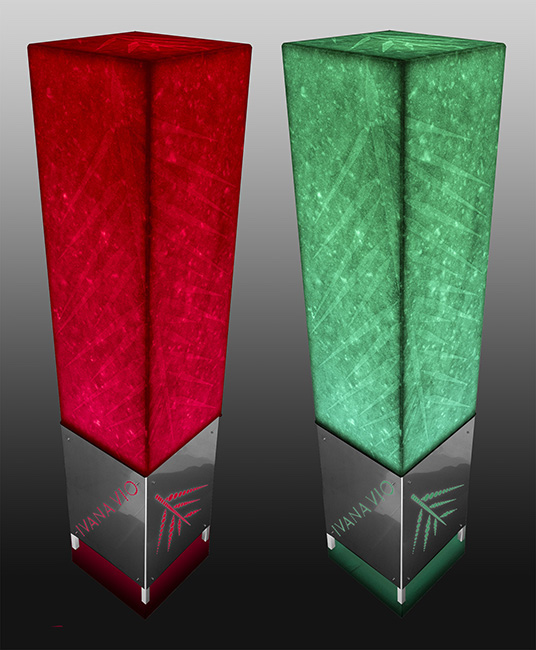
I LED da lei usati divengono così parte stessa delle sculture, elemento imprescindibile per il significato che rivestono, associandosi alla propositività che diviene metafora dell’atteggiamento dell’individuo, quell’essere consapevole che dopo il buio, il grigio, l’ombra, giunga sempre il giorno più luminoso; e dunque sta all’uomo la scelta se accogliere la non luce come momento positivo di preparazione a ciò che sopraggiungerà dopo oppure se viverlo in maniera negativa sospettando che permarrà per sempre.
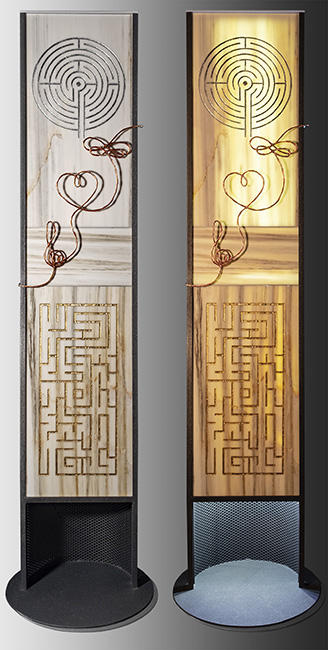
Nell’opera Arianna’s Thread (Filo di Arianna), appartenente alla serie Totem, la Vio affronta il tema del labirinto come allegoria della perdita di orientamento dell’essere umano contemporaneo la cui salvezza è quel filo, in quest’opera realizzato in trecciola di rame modellata, che può essere costituito dall’amore, intenso nel suo senso più ampio, perché quando l’uomo si perde tutto ciò che può fare è restare attaccato alle sue radici, ai suoi valori più profondi, a quei legami che non si dissolvono davanti a una strada impervia, e che sono necessari a infondergli coraggio e a sostenerlo anche nel momento in cui tentenna. La luminosità del LED sottolinea la positività della leggerezza, quell’armonia calda costituita proprio dal filo che si intreccia in un cuore perché è proprio lì, nel muscolo più importante ed emozionale del corpo umano, che risiede tutto ciò di cui si ha davvero bisogno.
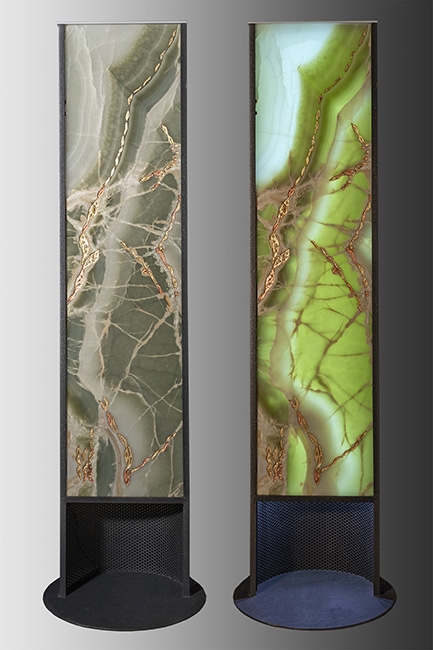
In Mediterraneo, della serie Totem, ciò che emerge è la differenza dell’aspetto dell’onice verde, più vicino al colore del sottobosco quando spento e molto più vivace e accomunabile alle tonalità chiare della vegetazione quando acceso, ma in entrambi i casi solcato da suggestive venature di foglia d’oro giallo e rosa che impreziosiscono ed evidenziano il naturale disegno della pietra. La struttura in ferro contiene l’onice che sembra incastonarsi nel vano che poi accoglie la luce, prestandosi a quell’eterno gioco di avvicendamento tra ciò che può diventare incredibilmente evidente e ciò che al contrario può restare più anonimo, defilato, nascosto se osservato con occhio distratto.
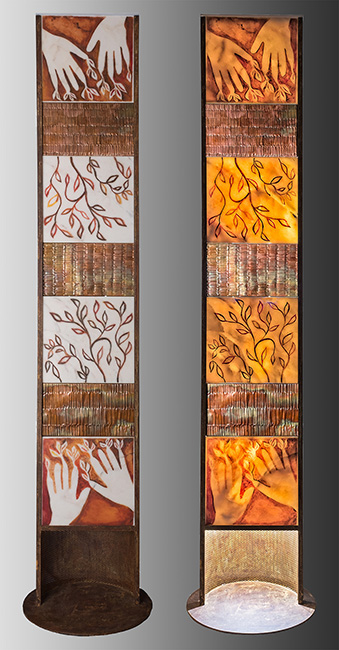
Nell’opera L’albero della vita Ivana Vio mescola tutti gli stili appresi nel suo percorso dunque la capacità di forgiare il marmo, nello specifico il delicato Rosa del Portogallo, effigiato con una doppia incisione, si associa all’abilità nel lavorare il rame, qui sbalzato e arricchito da pigmenti, per rappresentare la poesia immaginaria di un simbolo, l’albero appunto generatore di vita, che con le sue radici permette alle foglie, che rappresentano i frutti di quella vita, di svilupparsi e di rendersi autonome pur senza mai dimenticare le origini da cui sono nate.
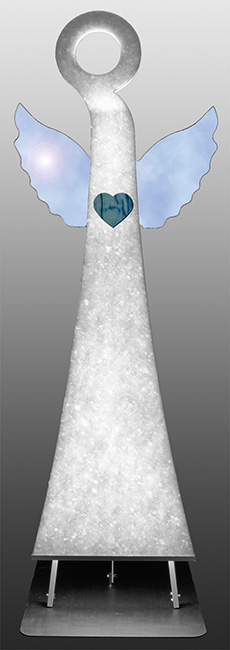
Ivana Vio ha eseguito due opere scultoree, la Via Crucis in marmo statuario di Carrara inciso e quella in onice e pigmento, che sono state alloggiate la prima presso la Chiesa dell’Istituto Suore Domenicane del S. Rosario e la seconda presso la Chiesa dell’Istituto Maria Ausiliatrice entrambe ad Alassio, e ha al suo attivo numerose mostre personali e collettive in Italia e all’estero – Parigi, Strasburgo, Berlino, Tirana, Abu Dhabi – che le hanno permesso di essere notata per la sua originalità. In passato ha collaborato con la rivista sperimentale parigina Plages e attualmente sta associando la passione per la fotografia alle sue opere di Body Art.
IVANA VIO-CONTATTI
Email: info@ivanavio.eu
Sito web: http://www.ivanavio.eu/home.html
Facebook: https://www.facebook.com/ivana.vio.7
Instagram: https://www.instagram.com/ivana.vio/
The luminous artworks by Ivana Vio, when light and shadow become interpretative filters of the same point of view
In art, as well as in contemporary everyday life, there is often a tendency to want to attain knowledge, truth, as if this could be attainable in an absolute and total sense, as if in fact there were no different versions subordinate to each individual’s approach and angle of observation; the more sensitive artists, who are more attentive to the relativity of reality, have instead a different kind of attitude, namely that of accepting possibilism, the undeniable concept that everything can have a subjective aspect and therefore no single truth can be induced or explained or given for certain, and thus become the means of inducing others to reflect, meditate and discover the multiple facets of everything that belongs to everyday existence. Today’s protagonist, with her stylistic multiplicity, shows in each of her works exactly this philosophical aspect, which is embodied in her luminous creations from which to receive different emotions depending on whether they are observed in the dark or in the sunlight.
In the context of those revolutionary and avant-garde decades that marked the beginning of the 20th century, many principles theorised by previous movements were taken up and expanded, transforming and adapting them to a new way of observing and generating art, but also embodying an unprecedented approach aimed at breaking the mould and the ties with academic rules and with a figuration that no longer seemed to be sufficient for the inclination of the creative artists of those years. In particular, there were currents that dictated new laws, new possibilities even with regard to cooperation between different forms of expression, allowing craftsmanship, architecture, interior design and decoration to interact directly with an artwork or even become an unprecedented artistic form that had until recently been considered as minor if not merely a technical discipline. Already with the English Arts and Crafts, the desire for a synergy, a profound interaction that would no longer allow craftsmanship to be considered second class, but rather to integrate art with its execution techniques, began to take shape; its evolution in French and Belgian Art Nouveau and Catalan Modernism, manifested itself in decorated stained glass windows, furniture production and architecture, of which there are still today astonishing testimonies of what was in fact a true revolution. Similarly, a few years later in Weimar, Germany, taking up the concept of the union and interaction of expressive forms, was born and consolidated a school of applied arts, the Bahuaus, which became a movement where students and teachers cooperated to study and interpret the new creative thought tending towards Informalism, to Abstractionism, Rationalism and Functionalism, where the design and realisation of a work extended not only to the final form but also to the materials and their interaction with the outside world, to aesthetic affinity, plastic balance and final impact. In fact, it was in the Weimar school that the relationship, now implemented and expanded, between culture and technology began to take shape, thus adding to the Arts and Crafts intuition the first steps towards the digitisation that is essential in many fields today.
It is precisely in this specific aspect that the artistic temperament of Ligurian artist Ivana Vio fits in, her intuitive need to explore, synergiise and deepen the reactions and behaviour of materials that she combines in her artworks through almost scientific techniques, learnt in her profession as an architect, by virtue of which she succeeds in giving originality, style and harmony to everything she creates. In her artistic career, which has always gone hand in hand with her work, she has measured herself with multiple techniques, from sculpture to Computer Art, from photography to Body Art, from engraving to embossing on metal, almost repeating the Bauhaus experience, which she has however pursued independently, choosing to frequent the artistic workshops of two great Genoese masters, the sculptor Quinto Testore and the painter Rocco Borella, and above all enriching it with what is her distinctive element, light. Yes, because Ivana Vio’s works are sculptures that can actually be turned on, observing details that when turned off remain invisible or barely noticeable, or they can be admired in daylight, where the reliefs and openings of the materials used allow to emerge shading and contrasts that dissolve in the light; her artistic research focuses on the exploration of unconventional techniques for modelling marble and metal, on attempting daring ways to make her creations unique, including through electrogalvanics with which she lets the less noble metal interact and dialogue with the more precious one, but also to highlight veins or grooves in the marble. The alternation between light and shadows therefore also enhances the effect generated by the precious metal, gold, which appears in many of her artworks almost as if her intervention were completing the necessary transition between one state and another, the on and the off, through which is manifested the alternation of life, the different capacity for each person to consider reality on the basis of their own existential approach.
The LEDs she uses thus become an integral part of the sculptures, an essential element for the meaning they hold, associating themselves with the propositionality that becomes a metaphor for the attitude of the individual, that being aware that after the darkness, the grey, the shadow, there always comes the brightest day; and so it is up to man to choose whether to welcome the non-light as a positive moment of preparation for what will come later, or to experience it negatively, suspecting that it will remain forever. In the artwork Arianna’s Thread, belonging to the Totem series, Vio tackles the theme of the labyrinth as an allegory of the contemporary human being’s loss of orientation, whose salvation is that thread, in this work made of moulded copper braid, which can be love, intense in its broadest sense, because when man loses his way all he can do is remain attached to his roots, to his deepest values, to those bonds that do not dissolve when faced with an impassable road, and that are necessary to infuse him with courage and sustain him even when he falters. The brightness of the LED underlines the positivity of lightness, that warm harmony constituted by the very thread that is woven into a heart, because it is there, in the most important and emotional muscle of the human body, that everything one really needs resides. In Mediterraneo, from the Totem series, what emerges is the difference in the appearance of the green onyx, closer to the colour of undergrowth when off and much more lively and similar to the light shades of vegetation when on, but in both cases furrowed by suggestive veins of yellow and pink gold leaf that embellish and highlight the natural design of the stone.
The iron structure contains the onyx that seems to be set in the space that then receives the light, lending itself to that eternal game of alternation between what can become incredibly evident and what, on the contrary, can remain more anonymous, defiladed, hidden if observed with a distracted eye. In the artwork The Tree of Life, Ivana Vio mixes all the styles she has learnt in her career: the ability to forge marble, specifically the delicate Rosa del Portogallo, effigyed with a double incision, is combined with the ability to work copper, here embossed and enriched with pigments, to represent the imaginary poetry of a symbol, the tree that generates life, which with its roots allows the leaves, representing the fruits of that life, to develop and become autonomous without ever forgetting the origins from which they were born. Ivana Vio has created two sculptural artworks, the Via Crucis in engraved Carrara marble statuary and the Via Crucis in onyx and pigment, the former housed in the Church of the Istituto Suore Domenicane del S. Rosario and the latter in the Church of the Istituto Maria Ausiliatrice both in Alassio. She has numerous solo and group exhibitions to her credit in Italy and abroad – Paris, Strasbourg, Berlin, Tirana, Abu Dhabi – which have allowed her to be noted for her originality. In the past, she collaborated with the experimental Parisian magazine Plages and is currently combining her passion for photography with her Body Art works.













